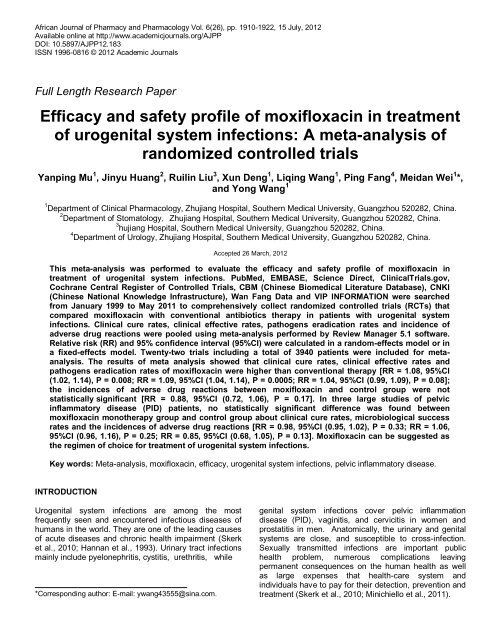Download Complete Issue (pdf 3800kb) - Academic Journals
Download Complete Issue (pdf 3800kb) - Academic Journals
Download Complete Issue (pdf 3800kb) - Academic Journals
Create successful ePaper yourself
Turn your PDF publications into a flip-book with our unique Google optimized e-Paper software.
African Journal of Pharmacy and Pharmacology Vol. 6(26), pp. 1910-1922, 15 July, 2012<br />
Available online at http://www.academicjournals.org/AJPP<br />
DOI: 10.5897/AJPP12.183<br />
ISSN 1996-0816 © 2012 <strong>Academic</strong> <strong>Journals</strong><br />
Full Length Research Paper<br />
Efficacy and safety profile of moxifloxacin in treatment<br />
of urogenital system infections: A meta-analysis of<br />
randomized controlled trials<br />
Yanping Mu 1 , Jinyu Huang 2 , Ruilin Liu 3 , Xun Deng 1 , Liqing Wang 1 , Ping Fang 4 , Meidan Wei 1 *,<br />
and Yong Wang 1<br />
1 Department of Clinical Pharmacology, Zhujiang Hospital, Southern Medical University, Guangzhou 520282, China.<br />
2 Department of Stomatology,Zhujiang Hospital, Southern Medical University, Guangzhou 520282, China.<br />
3 hujiang Hospital, Southern Medical University, Guangzhou 520282, China.<br />
4 Department of Urology, Zhujiang Hospital, Southern Medical University, Guangzhou 520282, China.<br />
Accepted 26 March, 2012<br />
This meta-analysis was performed to evaluate the efficacy and safety profile of moxifloxacin in<br />
treatment of urogenital system infections. PubMed, EMBASE, Science Direct, ClinicalTrials.gov,<br />
Cochrane Central Register of Controlled Trials, CBM (Chinese Biomedical Literature Database), CNKI<br />
(Chinese National Knowledge Infrastructure), Wan Fang Data and VIP INFORMATION were searched<br />
from January 1999 to May 2011 to comprehensively collect randomized controlled trials (RCTs) that<br />
compared moxifloxacin with conventional antibiotics therapy in patients with urogenital system<br />
infections. Clinical cure rates, clinical effective rates, pathogens eradication rates and incidence of<br />
adverse drug reactions were pooled using meta-analysis performed by Review Manager 5.1 software.<br />
Relative risk (RR) and 95% confidence interval (95%CI) were calculated in a random-effects model or in<br />
a fixed-effects model. Twenty-two trials including a total of 3940 patients were included for metaanalysis.<br />
The results of meta analysis showed that clinical cure rates, clinical effective rates and<br />
pathogens eradication rates of moxifloxacin were higher than conventional therapy [RR = 1.08, 95%CI<br />
(1.02, 1.14), P = 0.008; RR = 1.09, 95%CI (1.04, 1.14), P = 0.0005; RR = 1.04, 95%CI (0.99, 1.09), P = 0.08];<br />
the incidences of adverse drug reactions between moxifloxacin and control group were not<br />
statistically significant [RR = 0.88, 95%CI (0.72, 1.06), P = 0.17]. In three large studies of pelvic<br />
inflammatory disease (PID) patients, no statistically significant difference was found between<br />
moxifloxacin monotherapy group and control group about clinical cure rates, microbiological success<br />
rates and the incidences of adverse drug reactions [RR = 0.98, 95%CI (0.95, 1.02), P = 0.33; RR = 1.06,<br />
95%CI (0.96, 1.16), P = 0.25; RR = 0.85, 95%CI (0.68, 1.05), P = 0.13]. Moxifloxacin can be suggested as<br />
the regimen of choice for treatment of urogenital system infections.<br />
Key words: Meta-analysis, moxifloxacin, efficacy, urogenital system infections, pelvic inflammatory disease.<br />
INTRODUCTION<br />
Urogenital system infections are among the most<br />
frequently seen and encountered infectious diseases of<br />
humans in the world. They are one of the leading causes<br />
of acute diseases and chronic health impairment (Skerk<br />
et al., 2010; Hannan et al., 1993). Urinary tract infections<br />
mainly include pyelonephritis, cystitis, urethritis, while<br />
*Corresponding author: E-mail: ywang43555@sina.com.<br />
genital system infections cover pelvic inflammation<br />
disease (PID), vaginitis, and cervicitis in women and<br />
prostatitis in men. Anatomically, the urinary and genital<br />
systems are close, and susceptible to cross-infection.<br />
Sexually transmitted infections are important public<br />
health problem, numerous complications leaving<br />
permanent consequences on the human health as well<br />
as large expenses that health-care system and<br />
individuals have to pay for their detection, prevention and<br />
treatment (Skerk et al., 2010; Minichiello et al., 2011).

















